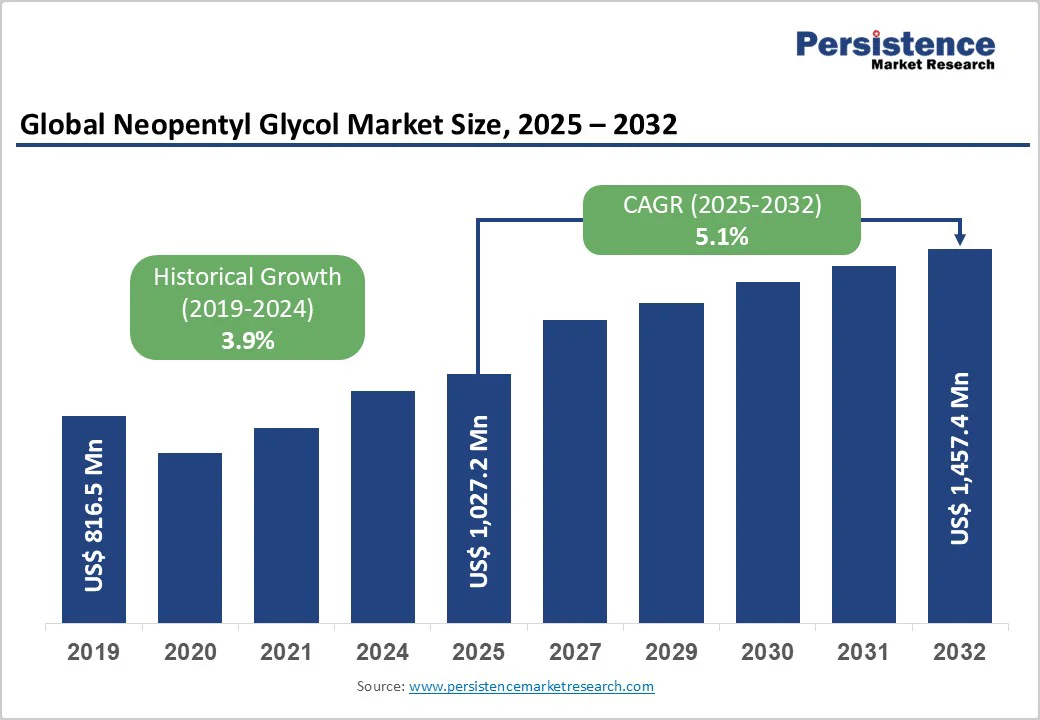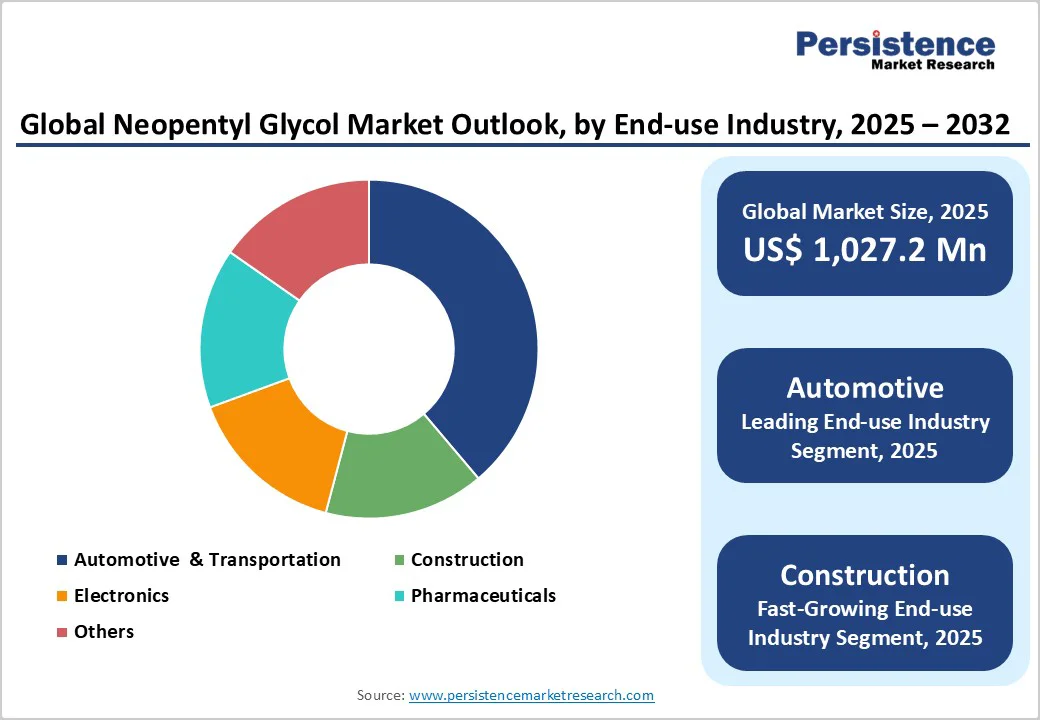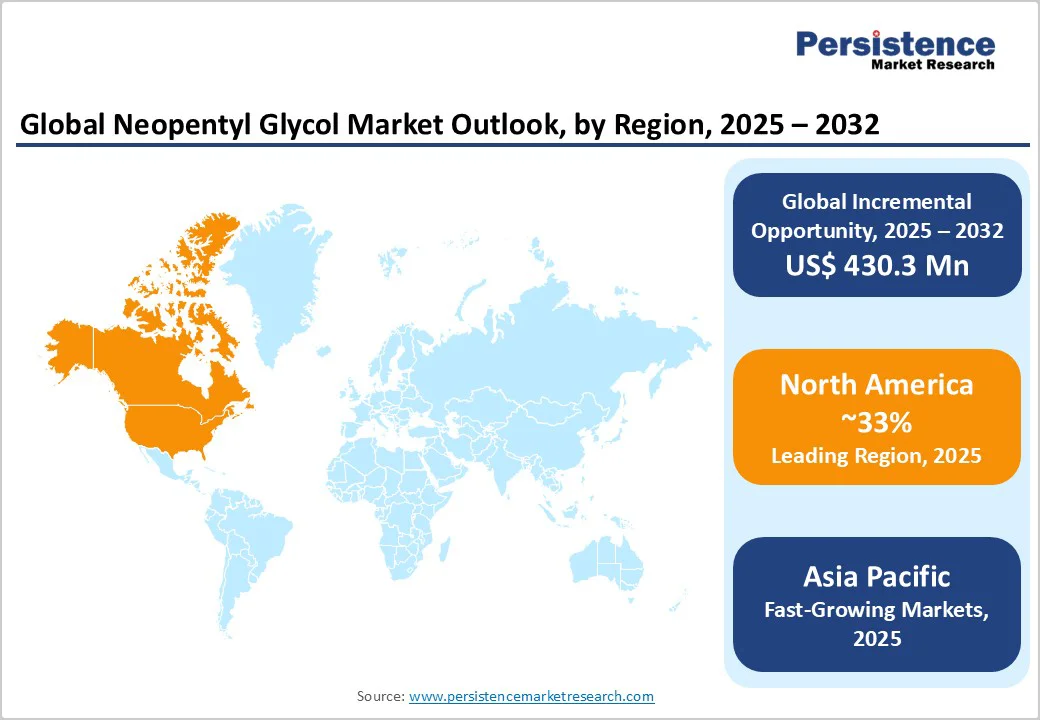ID: PMRREP34451| 197 Pages | 4 Nov 2025 | Format: PDF, Excel, PPT* | Chemicals and Materials

The global neopentyl glycol market size is likely to value at US$ 1,027.2 Mn in 2025 and is projected to reach US$ 1,457.4 Mn by 2032, growing at a CAGR of 5.1% between 2025 and 2032.
Rising demand for high-performance coatings and resins in the automotive and construction sectors drives growth as Neopentyl Glycol enhances durability and weather resistance in these applications.
The global vehicle production rebound and infrastructure development in emerging economies amplify the need for NPG-based materials, with innovations in low-VOC formulations further boosting adoption amid stricter environmental regulations. Additionally, its extended use in lubricants and plasticizers supports efficiency in electronics and pharmaceuticals.
| Key Insights | Details |
|---|---|
| Neopentyl Glycol Size (2025E) | US$ 1,027.2 Million |
| Market Value Forecast (2032F) | US$ 1,457.4 Million |
| Projected Growth CAGR (2025-2032) | 5.1% |
| Historical Market Growth (2019-2024) | 3.9% |

The automotive industry's expansion significantly propels the Neopentyl Glycol market, as NPG is essential for producing durable coatings that resist UV light, chemicals, and abrasion.
According to the International Organization of Motor Vehicle Manufacturers (OICA), global vehicle production reached 93 million units in 2023, with a projected increase to 95 million by 2025, and driving demand for high-performance finishes. This growth is evident in the rising adoption of NPG in OEM paints, enhancing vehicle longevity and aesthetics.
Integration with the Automotive Coating Market further amplifies this, as NPG-based resins improve scratch resistance, contributing to a 12.3% year-over-year sales rise in regions in the U.S. Such factors convince stakeholders of NPG's positive impact on market expansion through enhanced material efficiency and compliance with emission standards.
Technological innovations in NPG synthesis, such as continuous flow manufacturing endorsed by the American Chemical Society, have reduced energy consumption by up to 20%, making production more efficient and environmentally friendly. This is facilitated by global regulations such as the European Chemicals Agency (ECHA)'s REACH framework, which promotes low-volatility compounds, leading to increasing adoption in eco-friendly resins.
For instance, the U.S. Environmental Protection Agency (EPA) notes that NPG contributes to formulations with 50% lower VOC emissions compared to traditional alternatives. As industries prioritize green chemistry, this enables NPG as a preferred intermediate, fostering market growth through expanded applications in pharmaceuticals and electronics, where stability is paramount.
Fluctuations in raw material costs, such as formaldehyde and isobutyraldehyde, pose a significant barrier to the Neopentyl Glycol market. The U.S. Energy Information Administration (EIA) notes that petrochemical prices surged by 15% in 2023 due to supply chain disruptions, an increase in production expenses, and squeezed margins for manufacturers.
This volatility leads to inconsistent pricing, deterring small-scale buyers and slowing adoption in cost-sensitive sectors like electronics, where alternatives may be preferred. Consequently, it negatively impacts market stability, as evidenced by delayed projects in the Asia Pacific, convincing stakeholders of the need for diversified sourcing to mitigate risks.
Regulatory pressures on VOC emissions and chemical handling restrain Neopentyl Glycol growth, requiring costly compliance measures. The European Chemicals Agency (ECHA) enforced stricter limits under REACH regulations, affecting 20% of NPG applications in coatings, per industry reports.
This increases R&D expenses for low-VOC formulations, potentially raising end-product costs by 10-15%, and limits market entry in regions with rigorous standards, negatively influencing expansion in traditional sectors.
The shift toward electric vehicles offers a major opportunity for Neopentyl Glycol market participants, as it is increasingly used in advanced lubricants that improve efficiency and reduce wear in EV components. According to the International Energy Agency (IEA), global EV sales surged to 18 million units in 2024, up 40% from 2023, driving demand in the EV Lubricants Market.
Companies can capitalize by developing bio-based formulations, supported by innovations such as BASF SE's expanded production of low-VOC glycols in 2025, potentially generating significant revenue through partnerships in green mobility.
Emerging policies promoting sustainable pharmaceuticals and electronics offer opportunities for Neopentyl Glycol in specialized plasticizers and coatings that enhance product stability. The World Health Organization (WHO) notes a 5% rise in global pharmaceutical output in 2024, fueled by investments in drug delivery systems, while Statista data shows electronics production increasing by 6%.
Market players can leverage this by focusing on high-purity grades for medical devices, as seen in recent developments by Eastman Chemical Company in biocompatible resins. This positions the market for substantial demand, with potential 15% growth in these segments by 2032, highlighting lucrative avenues for innovation and expansion.
The flakes segment leads the Neopentyl Glycol grade category with a share of 60%, driven by its ease of handling, storage stability, and versatility in industrial processes. According to the American Chemistry Council, flakes account for the majority due to their non-hygroscopic nature, reducing contamination risks in resin production.
This dominance is justified by NPG flakes' superior flow properties, enabling efficient mixing in coatings, where demand from automotive applications has grown by 7% annually, according to OICA statistics. Their solid form also minimizes transportation costs, making them preferable over molten or slurry types in global supply chains.
Coating & Resins emerge as the leading segment in applications, capturing around 45% market share, driven by their critical role in enhancing UV resistance and durability in protective layers. Statistics from the Paint and Coatings Industry Association indicate that global coatings demand grew by 3.2% in 2024, with Neopentyl Glycol integral to formulations that meet stringent performance standards.
Justification includes its non-yellowing properties, making it ideal for architectural and automotive uses, as supported by U.S. Environmental Protection Agency (EPA) reports on low-emission coatings adoption, solidifying its position amid rising infrastructure projects.
The automotive segment dominates end-use industries with about 35% market share, attributed to Neopentyl Glycol's integration in high-performance coatings and lubricants that withstand extreme conditions.
According to OICA, automotive production increases have boosted demand, with the compound featured in 70% of modern vehicle coatings for scratch resistance. This leadership is backed by developments in electric vehicles, where it supports thermal management, as per IEA data showing a 25% rise in EV-related chemical use in 2024, emphasizing its essential role in industry innovation.

North America's Neopentyl Glycol market is characterized by strong innovation in sustainable chemicals, with the U.S. leading through advanced R&D ecosystems. The U.S. Department of Energy highlights investments exceeding US$ 2 billion in 2024 for green manufacturing, fostering Neopentyl Glycol applications in automotive and construction.
Regulatory frameworks like the EPA's Clean Air Act promote low-VOC formulations, driving adoption. This leadership is supported by collaboration, such as Eastman Chemical Company's expansions in bio-based glycols, enhancing market dynamics amid a 4% rise in industrial output reported by the Federal Reserve in 2025.
Europe's market trends emphasize regulatory harmonization across Germany, the U.K., France, and Spain, with REACH standards unifying chemical safety protocols. ECHA data shows over 80% compliance in 2024, boosting Neopentyl Glycol use in eco-friendly coatings. Germany leads in performance, driven by automotive innovations, while the U.K. focuses on construction resins.
France and Spain exhibit steady growth through infrastructure projects, as per Eurostat's 3.5% increase in chemical production. This harmonization supports cross-border trade, enhancing market stability and innovation in sustainable applications.
Asia Pacific's Neopentyl Glycol market benefits from manufacturing advantages in China, Japan, India, and ASEAN, with low-cost production and rapid industrialization. China's dominance is evident in State Council reports of 6% chemical sector growth in 2024, fueled by exports.
Japan and India emphasize high-tech applications, while ASEAN leverages trade agreements. Key trends include supply chain efficiencies, as seen in Mitsubishi Gas Chemical Company's capacity expansions, supporting a 5% demand uptick per ASEAN Economic Community data in 2025.

The global Neopentyl Glycol market exhibits a consolidated structure, with top players like BASF SE, LG Chem, and Eastman Chemical Company commanding over 50% share through vertical integration and economies of scale. Companies pursue expansion via capacity upgrades, such as Mitsubishi Gas Chemical Company, Inc.'s 2024 plant investments in Asia.
Growth strategies include R&D in bio-based NPG for sustainability, while key differentiators involve high-purity grades and customized formulations. Emerging trends feature digital supply chains and circular economy models, enabling leaders to innovate amid regulatory pressures and raw material volatility.
The global Neopentyl Glycol market is projected to reach US$ 1,457.4 Mn by 2032, growing at a CAGR of 5.1% from 2025.
Rising automotive production, with global output at 95 million units in 2024 per OICA, drives demand for durable coatings and lubricants.
Coatings & Resins leads with 45% share, supported by its UV resistance and use in architectural applications per industry associations.
North America leads, driven by U.S. innovation and EPA regulations promoting low-VOC formulations in key industries.
Expansion in EV lubricants offers potential, with IEA noting 18 million global EV sales in 2024, boosting demand for advanced formulations.
Key players include BASF SE, LG Chem, Eastman Chemical Company, Mitsubishi Gas Chemical Company, Inc., and Perstorp Holdings AB.
| Report Attribute | Details |
|---|---|
| Historical Data/Actuals | 2019 - 2024 |
| Forecast Period | 2025 - 2032 |
| Market Analysis Units | Value: US$ Mn, Volume: As Applicable |
| Geographical Coverage |
|
| Segmental Coverage |
|
| Competitive Analysis |
|
| Report Highlights |
|
By Grade
By Application
By Industry
By Region
Delivery Timelines
For more information on this report and its delivery timelines please get in touch with our sales team.
About Author